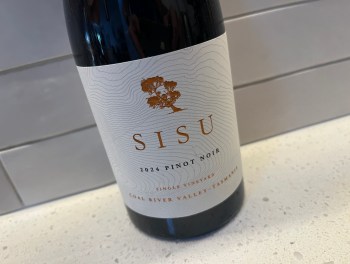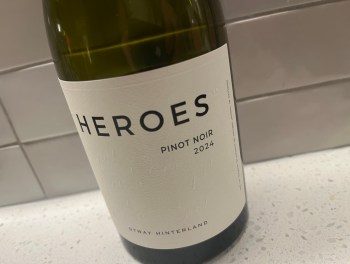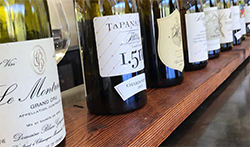I liked Verona.
There’s something beautifully romantic about this northern Italian city, the sentiment extending well beyond the tourists and tacky selfies in front of Juliet’s Balcony.
Romance, great food, and vines surrounding the city in many directions.
For today’s Thursday flashback then I’m heading back to fair Verona, delving deep into Valpolicella country to visit Valentina Cubi.
Now I still don’t know how I stumbled across this small producer, for the wines barely have a presence here in Australia. It was largely on a quest for organic Valpolicella that led me there, and I’m glad I popped in, if just to get a small winery perspective.
What immediately set this visit apart was that I was met by Valentina Cubi herself. I’m not sure what I was expecting, but it wasn’t the patron personally pouring wines. Valentina doesn’t look like a vigneron either, her mannerisms more like a teacher than wine producer (which makes sense, read on). That is until she starts barking commands at winery staff (my schoolboy Italian wasn’t good enough to keep up) and directing traffic for the first grapes of the season (non-organic Corvina to be sold off to a local producer). Then we’re back in wine producer multi-tasting territory.
There’s an interesting back story behind the label too, one that is not unusual in Italy with its proud matriarchal history, but more unusual in the male-dominated winemaking world…
Valentina Cubi was originally a primary school teacher, only landing in the wine game after she retired. It was her partner Giancarlo established the vineyard back in ’69, restarting the work of his father Albano who was killed in the Second World War. Giancarlo, however, was largely focused upon growing grapes rather than producing wine, and it took the influence of Valentina for the pair to start their label.
It was Valentina’s influence also that led to this small estate converting to organics. As of the 2014 vintage, the production will be all organic, save for one small patch of grapes that are sent elsewhere (which is what turned up during my visit).
Although wines made using dried grapes make up a significant part of the production here, Valentina lamented at length about the abandonment of the traditionally elegant (and quite delicious) Valpolicella style. After working through plenty of delicious, light-bodied Valpolicella Classico while in northern Italy in late summer, I can see exactly why you’d be saddened that this style is losing out to Amarone.
In the same breath, the best wines from Valentina Cubi all involved dried grapes. I only wrote short tasting notes here (and no scores), but what struck me was how classic everything tasted. Some of the wines are just a little dowdy, but the highlights are quite delicious – particularly the Recioto, a bottle of which followed me home.

Valentina Cubi Iperico Valpolicella Classico 2014
The entry point for the range, this sells for €7 locally. Largely Corvina, this is light, bright and spotless red fruited wine that sits a step above the flavourless supermarket Valpolicella, but it’s not a serious wine. Valentina believes that ‘Valpolicella should be fresh fruity for drinking everyday’ and this fits that ideal. 12% alc.
Valentina Cubi Il Tabarro Valpolicella Superiore 2013
More wise words from Valentina about this wine ‘Wine used to be a sort of food. Now they have Coca Cola’. Some ripasso with this blend of 65% Corvina, 25% Rondinella and 10% Molinara. Spends 6 months in barrel and 6 months in large vats. What is interesting here is how firm and even astringent it looks, especially after the simple vitality of the Iperico. You want to keep this as it’s just a bit raw and I wanted more of that generous fruit. 13% alc.
Valentina Cubi Morar Amarone 2006
The key to Amarone production according to Valentina is how important it is to pick the Amarone with dry skins. Wet skins = mould. The current vintage, this is 70% Corvina and 25% Corvinone, which Valentina believes is the key to great Amarone. Fruit was dried for 3 months drying then spent 30 months in big and small barrels. Again I found this very firm and astringent with obvious oak tannins – apparently this Amarone is too young, and that the peak period for drinking is 15-20 years. This is very much a structure-first wine, in contrast to the more lavish modern style. Indeed, this will probably live forever, though whether it resolves is another story. 15.5%
Valentina Cubi Morar Amarone 2005
‘We didn’t like this in the beginning – too tannic’ believes Valentina. Amazing how much more together this is compared to the 06 though. Open versus closed. It’s still a grandiose wine, but less about oak flavour on the palate (though plenty of oak tannins to finish) and more hints of caramel (oak) plus rum ‘n’ raisins. Length is, resounding and this feels like proper Amarone. Presence and power. 15.5%
Valentina Cubi Meliloto Recioto della Valpolicella 2010
Ahh, now we’re getting there! This is effectively the same grape makeup as the Valpolicella Superiore. 2 months drying, then a 40 ferment, leaving 96g/l RS. While the Amarone and Ripasso wines looked just a bit hard, the extra sweetness here made this plain delicious. Sugar doing its thing. There’s a wonderful amalgam of caramel, treacle, deep red fruit and then something juicier and vital too – almost like a dab of the straight Valpolicella went into the blend. The end result is obviously sweet but oh-so-together, the firm tannins and residual sugar walking hand-in-hand down your palate. Delicious really, if difficult to work out when you’d drink it. 16%
Help keep this site paywall free – donate here





4 Comments
High alcohol levels in the last 3!
True true. But probably about right for Amarone and Recioto styles. Definitely needs the extra sweetness to balance out the alcohol though.
Andrew, was the vintage of the second last wine 2006 or something different?
Sorted – ’twas the 05.